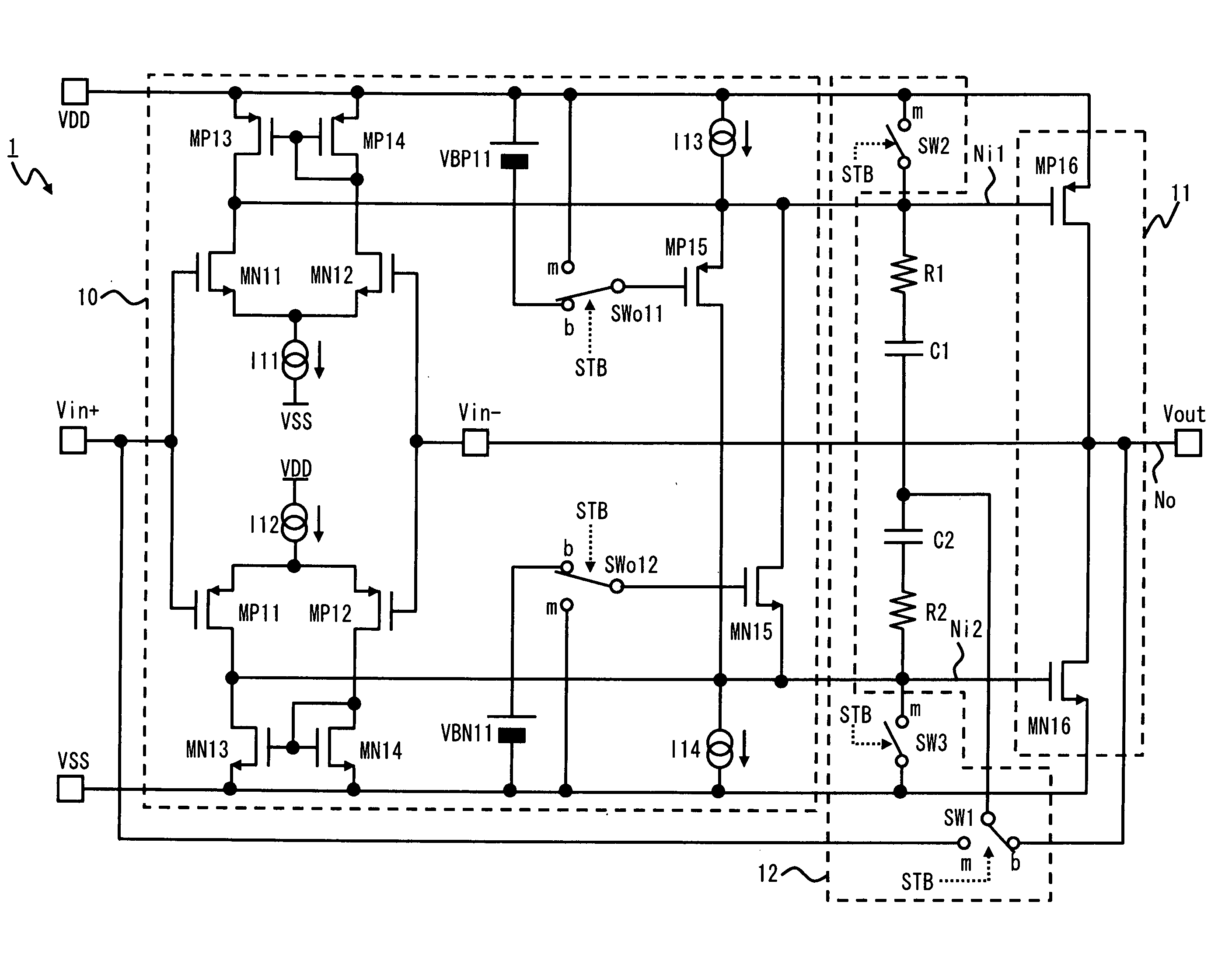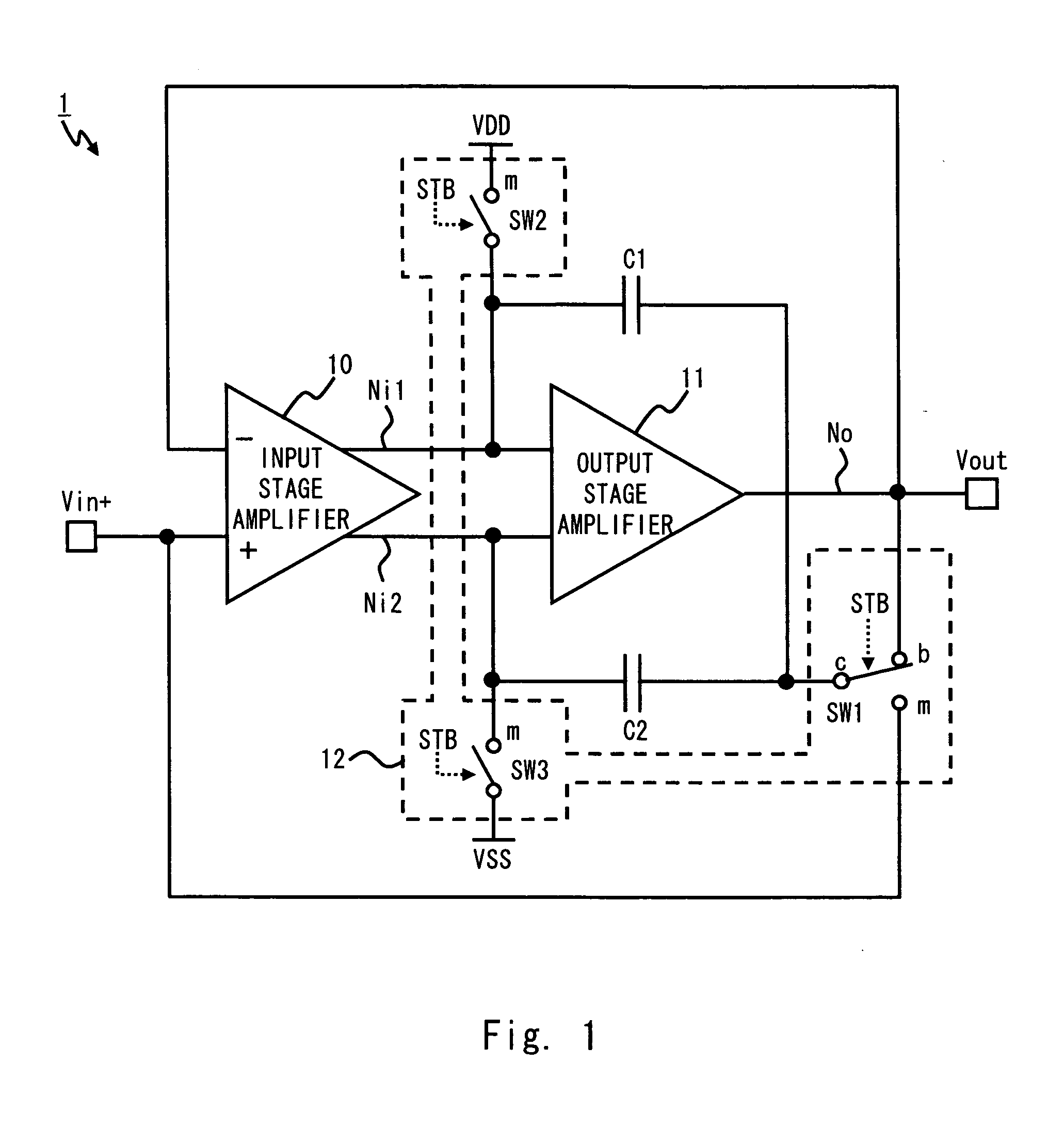Operational amplifier
a technology of operation amplifier and phase margin, which is applied in the direction of rf amplifier, gated amplifier, amplifier with semiconductor device/discharge tube, etc., can solve the problems of increased oscillation possibility, increased oscillation possibility, and difficulty in transmitting high-speed signals, so as to increase the slew rate and increase the capacitance of capacitors. , increase the phase margin
- Summary
- Abstract
- Description
- Claims
- Application Information
AI Technical Summary
Benefits of technology
Problems solved by technology
Method used
Image
Examples
first exemplary embodiment
[0031]Exemplary embodiments of the present invention are described hereinafter with reference to the drawings. FIG. 1 shows a block diagram of an operational amplifier 1 according to a first exemplary embodiment of the present invention. Referring to FIG. 1, the operational amplifier 1 includes an input stage amplifier 10, an output stage amplifier 11, a charge and discharge control circuit 12, a first capacitor (e.g. a capacitor C1), and a second capacitor (e.g. a capacitor C2). The input stage amplifier 10 has a non-inverting input terminal and an inverting input terminal. The input stage amplifier 10 and the output stage amplifier 11 are connected in series, and the output node of the output stage amplifier 11 is connected to the inverting input terminal of the input stage amplifier 10. The operational amplifier 1 thereby operates as a buffer.
[0032]The input stage amplifier 10 outputs a first signal and a second signal that are in-phase with each other based on a signal input to ...
second exemplary embodiment
[0071]FIG. 8 is a block diagram showing an operational amplifier 2 according to a second exemplary embodiment of the present invention. Referring to FIG. 8, the operational amplifier 2 is configured by altering the connection of the switch SW1 in the operational amplifier 1 and adding a voltage source VG1 as the first power supply. In the switch SW1 of the operational amplifier 2, the terminals of the capacitors C1 and C2 on the output node side are connected to the common terminal c, the output node No is connected to the break terminal b, and the positive electrode of the voltage source VG1 is connected to the make terminal m. The negative electrode of the voltage source VG1 is connected to the negative power supply VSS.
[0072]Thus, in the operational amplifier 2, it is possible to arbitrarily set the voltages to be applied to the terminals of the capacitors C1 and C2 on the output node side during the charge recovery period according to the setting of the voltage value to be gener...
third exemplary embodiment
[0073]FIG. 9 is a block diagram showing an operational amplifier 3 according to a third exemplary embodiment of the present invention. Referring to FIG. 9, the operational amplifier 3 is configured by replacing the second switch (the switch SW2 and the switch SW3) in the operational amplifier 1 with transfer type switches and adding voltage sources VG2 and VG3 as the second power supply. In the switch SW2 of the operational amplifier 3, the terminal of the capacitor C1 on the input node side is connected to the common terminal c, the input node Ni1 is connected to the break terminal b, and the negative electrode of the voltage source VG2 is connected to the make terminal m. The positive electrode of the voltage source VG2 is connected to the positive power supply VDD. In the switch SW3 of the operational amplifier 3, the terminal of the capacitor C2 on the input node side is connected to the common terminal c, the input node Ni2 is connected to the break terminal b, and the positive...
PUM
 Login to View More
Login to View More Abstract
Description
Claims
Application Information
 Login to View More
Login to View More - R&D
- Intellectual Property
- Life Sciences
- Materials
- Tech Scout
- Unparalleled Data Quality
- Higher Quality Content
- 60% Fewer Hallucinations
Browse by: Latest US Patents, China's latest patents, Technical Efficacy Thesaurus, Application Domain, Technology Topic, Popular Technical Reports.
© 2025 PatSnap. All rights reserved.Legal|Privacy policy|Modern Slavery Act Transparency Statement|Sitemap|About US| Contact US: help@patsnap.com



